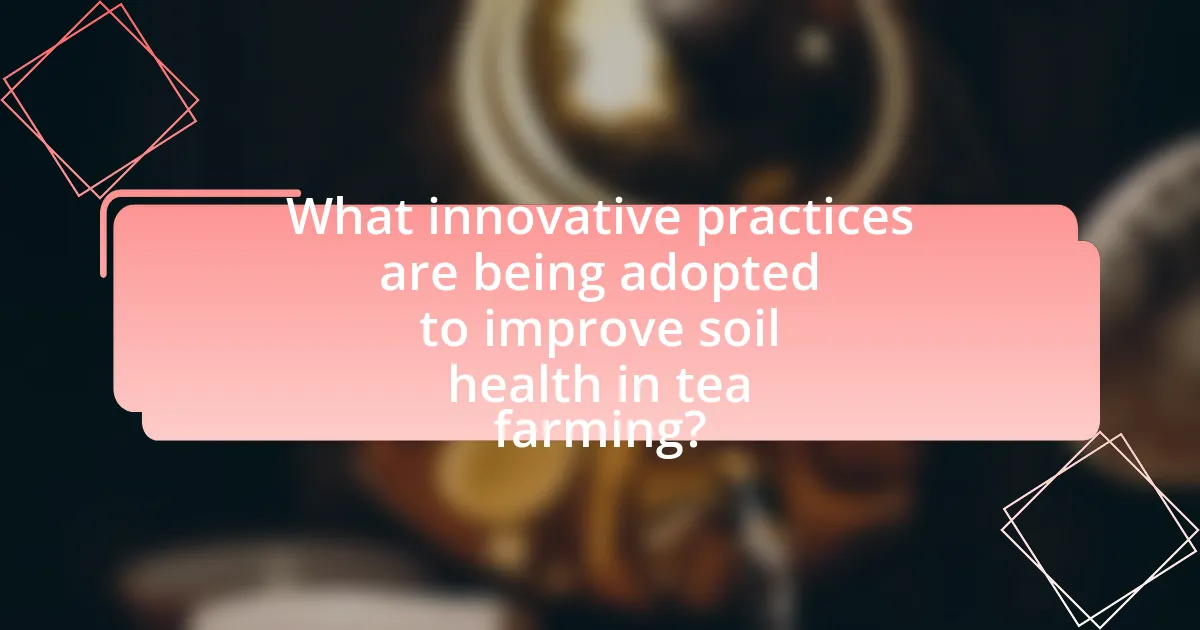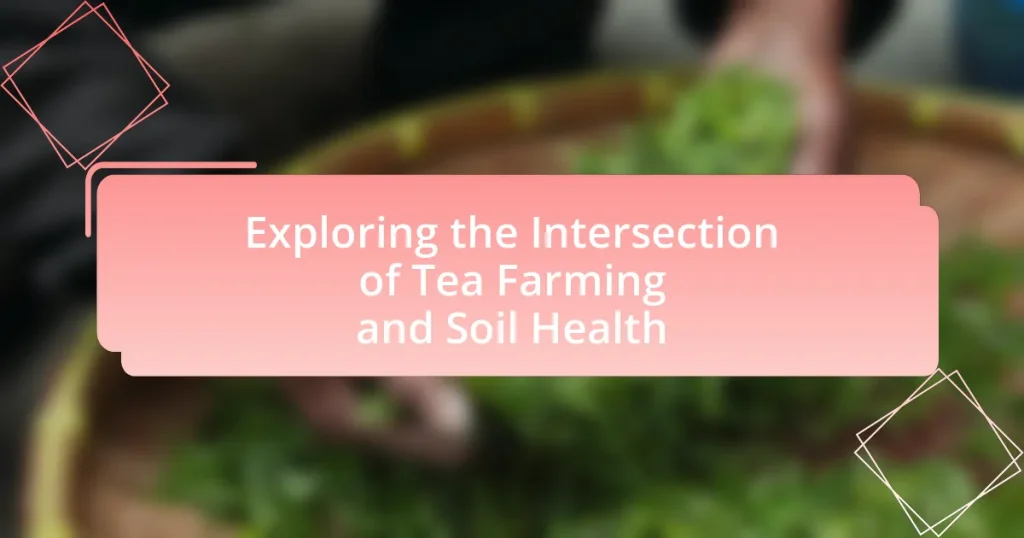The article focuses on the relationship between tea farming and soil health, highlighting how tea cultivation affects soil structure, nutrient availability, and microbial activity. It examines the impact of soil health on tea farming practices, including plant growth, yield, and quality, while identifying key indicators of soil health such as organic matter, nutrient levels, and microbial activity. The article also discusses the challenges of maintaining soil health in tea farming, the influence of climate change, and innovative practices like organic farming and precision agriculture that can enhance soil fertility and sustainability. Additionally, it emphasizes the importance of soil management and regular testing in optimizing tea production.

What is the relationship between tea farming and soil health?
Tea farming significantly impacts soil health by influencing soil structure, nutrient availability, and microbial activity. The cultivation of tea plants requires specific soil conditions, which can lead to both positive and negative effects on soil health. For instance, tea plants thrive in well-drained, acidic soils rich in organic matter, which can enhance soil fertility when managed sustainably. However, intensive tea farming practices, such as excessive use of fertilizers and pesticides, can degrade soil quality, reduce biodiversity, and lead to soil erosion. Research indicates that sustainable practices, such as agroforestry and organic farming, can improve soil health by promoting microbial diversity and enhancing soil organic carbon content, thereby creating a more resilient ecosystem for tea cultivation.
How does soil health impact tea farming practices?
Soil health significantly impacts tea farming practices by influencing plant growth, yield, and quality. Healthy soil enhances nutrient availability, improves water retention, and promotes beneficial microbial activity, which are essential for the optimal growth of tea plants. Research indicates that tea plants thrive in well-structured, nutrient-rich soils, leading to higher yields and better flavor profiles. For instance, a study published in the Journal of Agricultural Science found that tea cultivated in soils with high organic matter content produced leaves with superior taste and aroma, demonstrating the direct correlation between soil health and tea quality.
What are the key indicators of soil health in tea plantations?
Key indicators of soil health in tea plantations include soil organic matter, nutrient availability, soil pH, microbial activity, and soil structure. Soil organic matter is crucial as it enhances nutrient retention and water-holding capacity, which are vital for tea plant growth. Nutrient availability, particularly nitrogen, phosphorus, and potassium, directly affects tea yield and quality. Soil pH influences nutrient solubility and microbial activity; optimal pH levels for tea are typically between 4.5 and 6.0. Microbial activity indicates biological health and nutrient cycling, while good soil structure promotes root development and water infiltration. These indicators collectively ensure the sustainability and productivity of tea plantations.
How do soil nutrients affect tea plant growth and quality?
Soil nutrients significantly influence tea plant growth and quality by providing essential elements required for optimal physiological processes. Nutrients such as nitrogen, phosphorus, and potassium are crucial for leaf development, root growth, and overall plant health. For instance, nitrogen promotes vigorous vegetative growth and enhances the production of amino acids, which are vital for flavor compounds in tea. Phosphorus supports root development and energy transfer, while potassium regulates water uptake and improves drought resistance. Research indicates that balanced soil nutrient levels can lead to higher yields and improved tea quality, as evidenced by studies showing that tea plants grown in nutrient-rich soils produce leaves with higher concentrations of desirable polyphenols and flavonoids, which contribute to flavor and health benefits.
Why is soil management crucial for sustainable tea farming?
Soil management is crucial for sustainable tea farming because it directly influences plant health, yield, and environmental sustainability. Healthy soil enhances nutrient availability, supports beneficial microorganisms, and improves water retention, all of which are essential for optimal tea growth. Research indicates that well-managed soils can increase tea yields by up to 30% compared to poorly managed soils, demonstrating the significant impact of soil health on productivity. Furthermore, effective soil management practices, such as crop rotation and organic amendments, help prevent soil erosion and degradation, ensuring long-term viability of tea plantations.
What practices enhance soil fertility in tea cultivation?
Practices that enhance soil fertility in tea cultivation include the application of organic matter, crop rotation, and the use of cover crops. Organic matter, such as compost and green manure, improves soil structure and nutrient availability, which is crucial for tea plants. Crop rotation helps prevent nutrient depletion and reduces pest and disease pressure, thereby maintaining soil health. Additionally, cover crops, like legumes, fix nitrogen in the soil, further enriching it. These practices are supported by research indicating that organic amendments can increase soil organic carbon levels and microbial activity, essential for sustainable tea farming.
How does soil erosion affect tea production?
Soil erosion negatively impacts tea production by depleting the nutrient-rich topsoil essential for healthy plant growth. The loss of topsoil reduces the availability of vital nutrients such as nitrogen, phosphorus, and potassium, which are crucial for the development of tea plants. Studies indicate that areas experiencing significant soil erosion can see a decline in tea yield by up to 30%, as the compromised soil structure affects water retention and root development. Additionally, erosion can lead to increased sedimentation in nearby water sources, further affecting irrigation quality and availability for tea cultivation.

What are the challenges faced in maintaining soil health in tea farming?
Maintaining soil health in tea farming faces several challenges, including soil erosion, nutrient depletion, and contamination from agrochemicals. Soil erosion occurs due to the steep terrains often used for tea cultivation, leading to the loss of topsoil and essential nutrients. Nutrient depletion arises from continuous cropping without adequate replenishment, which can diminish soil fertility over time. Additionally, the use of fertilizers and pesticides can lead to soil contamination, negatively impacting microbial activity and overall soil health. These challenges are critical as they directly affect tea yield and quality, making sustainable soil management essential for the longevity of tea farming.
How do climate change and environmental factors influence soil health?
Climate change and environmental factors significantly influence soil health by altering temperature, precipitation patterns, and the frequency of extreme weather events. These changes can lead to soil erosion, nutrient depletion, and reduced organic matter, which are critical for maintaining soil fertility. For instance, increased rainfall intensity can cause runoff, washing away topsoil and essential nutrients, while higher temperatures can accelerate organic matter decomposition, further diminishing soil quality. Research indicates that soil degradation affects agricultural productivity, with studies showing that up to 30% of global soils are already degraded due to these factors, impacting food security and ecosystem stability.
What specific climate challenges affect tea-growing regions?
Tea-growing regions face specific climate challenges such as rising temperatures, altered precipitation patterns, and increased frequency of extreme weather events. Rising temperatures can lead to heat stress in tea plants, negatively impacting yield and quality. Altered precipitation patterns can cause droughts or excessive rainfall, both of which can harm soil health and disrupt the growth cycle of tea plants. Additionally, increased frequency of extreme weather events, such as storms and floods, can lead to soil erosion and loss of nutrients, further threatening tea cultivation. These challenges are supported by research indicating that climate change is projected to reduce suitable areas for tea cultivation by up to 50% by 2050, highlighting the urgency of addressing these climate impacts on tea farming.
How can tea farmers adapt to changing soil conditions?
Tea farmers can adapt to changing soil conditions by implementing soil management practices such as crop rotation, cover cropping, and the use of organic amendments. These practices enhance soil structure, improve nutrient availability, and increase resilience to erosion and nutrient depletion. Research indicates that crop rotation can reduce soil-borne diseases and improve soil fertility, while cover crops can prevent soil erosion and enhance moisture retention. Additionally, incorporating organic matter, such as compost or green manure, can significantly improve soil health and its ability to support tea plants under varying conditions.
What role do pests and diseases play in soil health?
Pests and diseases significantly impact soil health by influencing microbial diversity and nutrient cycling. They can disrupt the balance of soil ecosystems, leading to reduced organic matter decomposition and altered nutrient availability. For instance, certain pests may introduce pathogens that harm beneficial soil organisms, thereby diminishing soil fertility. Research indicates that healthy soil ecosystems, characterized by a diverse microbial community, are more resilient to pest and disease pressures, which underscores the importance of integrated pest management in maintaining soil health in agricultural systems, including tea farming.
How do soil-borne diseases impact tea crops?
Soil-borne diseases significantly impact tea crops by reducing yield and quality. These diseases, caused by pathogens such as fungi, bacteria, and nematodes, can lead to root rot, wilting, and stunted growth in tea plants. For instance, research indicates that Fusarium wilt, a common soil-borne disease, can cause up to 50% yield loss in affected tea plantations. Additionally, the presence of these pathogens can compromise the overall health of the soil, leading to decreased nutrient availability and further hindering tea crop productivity.
What integrated pest management strategies can protect soil health?
Integrated pest management (IPM) strategies that protect soil health include crop rotation, the use of cover crops, and biological control methods. Crop rotation disrupts pest life cycles and enhances soil structure, while cover crops improve soil organic matter and prevent erosion. Biological control methods, such as introducing natural predators, reduce reliance on chemical pesticides, thereby minimizing soil contamination and preserving microbial diversity. Research indicates that these practices not only manage pests effectively but also contribute to sustainable soil health by maintaining nutrient levels and enhancing soil resilience.

What innovative practices are being adopted to improve soil health in tea farming?
Innovative practices being adopted to improve soil health in tea farming include the use of cover cropping, organic amendments, and agroforestry techniques. Cover cropping, such as planting legumes, enhances soil fertility and structure by fixing nitrogen and preventing erosion. Organic amendments, like compost and green manure, enrich the soil with nutrients and improve microbial activity. Agroforestry integrates trees with tea plants, promoting biodiversity and enhancing soil moisture retention. These practices are supported by studies indicating that they significantly increase soil organic matter and microbial diversity, leading to healthier tea plantations.
How can organic farming techniques benefit soil health in tea cultivation?
Organic farming techniques can significantly enhance soil health in tea cultivation by promoting biodiversity, improving soil structure, and increasing nutrient availability. These techniques, such as crop rotation, cover cropping, and the use of organic fertilizers, contribute to a balanced ecosystem that supports beneficial microorganisms. Research indicates that organic practices can increase soil organic matter by up to 30%, which enhances soil aeration and water retention, crucial for tea plants. Additionally, organic farming reduces chemical inputs, leading to healthier soil microbiomes that improve nutrient cycling and overall soil fertility.
What are the advantages of using cover crops in tea plantations?
Using cover crops in tea plantations enhances soil health, improves biodiversity, and reduces erosion. Cover crops, such as legumes and grasses, contribute to soil fertility by fixing nitrogen and increasing organic matter, which supports tea plant growth. Research indicates that cover crops can reduce soil erosion by up to 50%, thereby maintaining soil structure and preventing nutrient loss. Additionally, they promote beneficial microorganisms, which can improve pest resistance and overall ecosystem health within the tea plantation.
How does composting contribute to soil health in tea farming?
Composting significantly enhances soil health in tea farming by improving soil structure, increasing nutrient availability, and promoting microbial activity. The organic matter from compost enriches the soil, leading to better water retention and aeration, which are crucial for tea plant growth. Additionally, compost provides essential nutrients such as nitrogen, phosphorus, and potassium, which are vital for the development of tea plants. Research indicates that compost application can increase soil organic carbon levels, thereby enhancing soil fertility and overall productivity in tea cultivation.
What technologies are being utilized to monitor soil health?
Technologies utilized to monitor soil health include remote sensing, soil sensors, and data analytics platforms. Remote sensing employs satellite imagery and drones to assess soil moisture, temperature, and nutrient levels over large areas, providing comprehensive data for farmers. Soil sensors, such as moisture and pH sensors, offer real-time data on soil conditions, enabling precise management of soil health. Data analytics platforms integrate information from various sources, allowing for detailed analysis and decision-making regarding soil management practices. These technologies collectively enhance the ability to monitor and improve soil health effectively.
How do soil sensors and data analytics improve farming outcomes?
Soil sensors and data analytics significantly improve farming outcomes by providing real-time insights into soil conditions, enabling precise management of resources. These technologies allow farmers to monitor moisture levels, nutrient content, and pH, which leads to optimized irrigation and fertilization practices. For instance, a study published in the journal “Precision Agriculture” found that farms utilizing soil sensors increased crop yields by up to 20% due to better-informed decision-making based on accurate soil data. This data-driven approach minimizes waste and enhances productivity, ultimately leading to more sustainable farming practices.
What role does precision agriculture play in tea farming?
Precision agriculture significantly enhances tea farming by optimizing resource use and improving crop yields. This approach employs technologies such as GPS, soil sensors, and data analytics to monitor and manage field variability, allowing farmers to apply water, fertilizers, and pesticides more efficiently. For instance, studies have shown that precision agriculture can increase tea yields by up to 20% while reducing input costs by 10-15%, demonstrating its effectiveness in promoting sustainable farming practices.
What best practices can tea farmers implement for optimal soil health?
Tea farmers can implement practices such as cover cropping, organic amendments, and crop rotation to achieve optimal soil health. Cover cropping involves planting specific crops during off-seasons to enhance soil structure and prevent erosion, which has been shown to improve soil fertility and moisture retention. Organic amendments, such as compost or green manure, enrich the soil with nutrients and promote beneficial microbial activity, leading to healthier soil ecosystems. Crop rotation helps break pest and disease cycles while improving nutrient availability, as different crops utilize soil nutrients differently. Research indicates that these practices can significantly enhance soil organic matter and overall soil health, leading to more sustainable tea production.
How can regular soil testing improve tea farming practices?
Regular soil testing can significantly enhance tea farming practices by providing precise information about soil nutrient levels and pH balance. This data enables farmers to tailor their fertilization and soil management strategies, ensuring optimal growth conditions for tea plants. For instance, a study published in the Journal of Agricultural Science found that soil testing led to a 20% increase in tea yield by allowing farmers to apply the right nutrients at the right time. Additionally, regular testing helps in identifying soil health issues, such as compaction or erosion, which can adversely affect tea quality and productivity. By addressing these issues proactively, tea farmers can improve both the quantity and quality of their harvests.
What are the benefits of crop rotation in tea cultivation?
Crop rotation in tea cultivation enhances soil health and increases yield. By alternating tea with other crops, farmers can improve soil fertility, reduce pest and disease pressure, and enhance biodiversity. For instance, legumes used in rotation can fix nitrogen in the soil, benefiting subsequent tea crops. Research indicates that crop rotation can lead to a 10-20% increase in tea yield due to improved soil structure and nutrient availability. Additionally, rotating crops helps break the life cycles of pests and diseases specific to tea, leading to reduced reliance on chemical pesticides.


